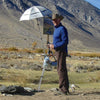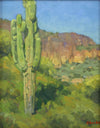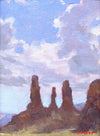
Gregory Hull Biography
"I have been an oil painter since high school. I knew I wanted to be an artist from an early age and I was always sketching, drawing and coloring. In high school, a teacher encouraged me to explore my passion. He gave me an old set of oil paints as he was exploring the "new" acrylics and I immediately liked them and their textural qualities and the slower drying time which allowed them to be worked and added to.
After attending Utah State University for one year trying to find myself, I transferred to the University of Utah where I met and immediately admired the work of Alvin Gittins . He became my teacher and mentor for the next 5 years. After receiving my Master of Fine Arts degree in 1977, I moved to Los Angeles to search for a gallery situation and I was fortunate to be picked up by Wally Findlay Galleries in Beverly Hills. They were especially interested in my still life works which became the bulk of my sales for 15 years.
I had dabbled in outdoor work since high school and I continued to be interested in impressionism and in working “en plein air" and gradually this desire for the free, wide-open spaces became my passion and I worked to be good at it..I have always loved to travel and see new places and paint these locations, some of them quite remote and difficult to get to. Pack trips into the High Sierras in California and the Wind River Range in Wyoming come to mind, as do river trips through the Grand Canyon in Arizona, as well as extended stays in Spain and Italy.
MUSINGS
Why do we like to paint outdoors? To arrive at a spot and to be inspired by nature to set up your gear and begin painting requires a burst of energy. The landscape can be a vehicle for all sorts of emotions: happiness, contentment, melancholy, exuberance, joy, etc. I think your emotions show through in the finished painting and thus communicate your feelings to others. A painting on the wall is like a window to other worlds to which we can escape and which triggers emotional and intellectual responses from the viewer. What greater goal of art than this?
My approach to painting is to scout a certain area for good subjects. Usually I'm struck almost immediately with the sensation that this is the "spot" and I usually go with that impression. I throw my stuff down and begin setting up. I decide the size of the canvas, the horizontal or vertical format, and ready my materials. I may at this time choose to stain the canvas with a complimentary color; i.e., a transparent stain in a complimentary color to what the general temperature of the painting is. In many cases, the general tone of the painting is cool, therefore a wash of alizarin crimson mixed with a little cadmium red light or orange serves as a foil for the cool colors that will go over this.
Sometimes, I will work on a white canvas, enjoying the brilliance of the white. After all, the light of day is usually very bright and high keyed. I may next experiment with the compositional elements. It takes very few elements to make up a good painting. A mountain, a couple of trees, some water are some of the elements one might choose. Usually there is a horizon line involved. I experiment doing small thumbnail sketches until I'm sure of the strength of the composition. A painting is not the sum total of a bunch of details, but rather the careful choosing and simplifying of the scene. The tendency is for nature to overwhelm us in all her complexity and it's the painter's job to simplify and generalize to create the "feeling" of this complexity without painting every tiny detail.
I then begin working very fast, trusting my instincts of color mixing. I may work from thin to thick or just start putting on heavy paint right from the first, but in any case, I want to get my major elements laid in quickly so the thing begins to work on a simple level. Then I can go on refining areas and making color and value corrections until I'm satisfied or pleased with the result and there is some sort of degree of polish that is arbitrarily established. I then look at the painting and wonder if anything I would do to it would improve it or not, and decide to pack it in, so to speak. If in this process you think your painting needs something more and it will be improved by these changes, by all means I would do them.
Once while painting near a railroad track, an Amtrak passenger train whizzed by and the wind created at the end of the trainlifted my entire setup off the ground and tipped it over, my mineral spirits washing off half of the painting which was almost finished. In my ire, I had the good sense to pick everything up, dust it off, and begin laying in the missing parts of the painting, which, since I had painted it already, were easy to put down again and with a much-improved confidence.
I ended up being pleased with the result. My point is that lots can be learned from not being too precious with your work, but at the same time, if changes will not benefit the painting, I don't recommend doing anything else. Move on.
We learn from every painting and more than anything else, it's in the process where we learn. The finished product is just that, the residue of our investigation. While we can learn from studying the good and bad elements of our paintings, sometimes it's good to move forward and keep painting. That is why I advocate speed in doing an outdoor painting. After 2 or 3 hours, the light has changed completely and there is no sense in working on something all day long, changing the light on the painting to match the changing light from the sun.
There was, to begin with, something about that scene that grabbed you and made you want to paint it and sticking to that original plan is a good idea. By laying in the lights and shadows almost immediately, changes in light won't affect the painting. Sometimes, for example in the late afternoon, the shadows will improve and become more dramatic. I know from my experience when this will happen and I try to anticipate it in my painting, so I will emphasize my shadows and paint with the moving light. At times, this is serendipitous and a good result occurs, most likely a simplification of the shadow areas and an overall softening of the colors.
I love to paint along the California coast because of the beautiful, almost palpable atmosphere. You can understand painters' attraction to this beautiful state with its varied subjects encompassing almost every climatic zone. The coast is especially beguiling to me. It's almost always the perfect temperature year-round and the proximity of the ocean with all its scents and sounds, makes painting there a pleasure. Even on cool, foggy days, my childhood memories are called up, when I first saw the ocean at age 14 on the coast of Oregon."







